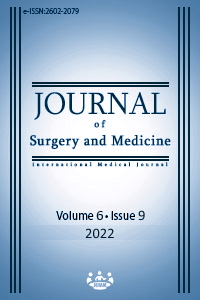Exploring the relationship between preeclampsia and human epididymis protein 4
Preeclampsia and human epididymis protein 4
Keywords:
HE4 protein, Preeclampsia, Protease inhibitorAbstract
Background/Aim: The level of human epididymis protein 4 (HE4), a glycoprotein and protease inhibitor, increases under many malignancies and inflammatory conditions. HE4 is also associated with cell invasion, migration, and adhesion. In this study, we compared the HE4 protein levels in pregnant patients with preeclampsia to healthy pregnant and non-pregnant individuals with the aim of finding a biomarker that can be used to recognize preeclampsia.
Methods: Our study is a prospective case control study and included 20 pregnant women with preeclampsia, 20 pregnant women without preeclampsia, and 20 healthy non-pregnant women (the control). The participants’ serum HE4 levels were analyzed statistically.
Results: Data analysis revealed that the mean HE4 levels were significantly lower in the preeclampsia group than in the other two groups (P = 0.002). Mean HE4 protein levels were also lower in the non-pregnant women than in the pregnant women without preeclampsia; however, this difference was not significant.
Conclusion: It is difficult to predict preeclampsia, and there is not any sensitive or specific biomarker for determining the condition. This study may support that HE4 protein may be useful and significant in predicting preeclampsia. The results we achieved provide proof that HE4 levels could be a potential biomarker for preeclampsia. Many more comprehensive studies are needed to support the association between HE4 protein and preeclampsia.
Downloads
References
McCarthy FP, Ryan RM, Chappell LC. Prospective biomarkers in preterm preeclampsia: A review. Pregnancy Hypertension. 2018;14:72-8. DOI: https://doi.org/10.1016/j.preghy.2018.03.010
Abalos E, Cuesta C, Grosso AL, Chou D, Say L. Global and regional estimates of preeclampsia and eclampsia: a systematic review. Eur J Obstet Gynecol Reprod Biol. 2013;170(1):1-7. DOI: https://doi.org/10.1016/j.ejogrb.2013.05.005
Fisher SJ. Why is placentation abnormal in preeclampsia? American Journal of Obstetrics and Gynecology. 2015;213(4 Suppl):S115-22. DOI: https://doi.org/10.1016/j.ajog.2015.08.042
Lim KH, Zhou Y, Janatpour M, McMaster M, Bass K, Chun SH, et al. Human cytotrophoblast differentiation/invasion is abnormal in pre-eclampsia. The American Journal of Pathology. 1997;151(6):1809-18.
Librach CL, Werb Z, Fitzgerald ML, Chiu K, Corwin NM, Esteves RA, et al. 92-kD type IV collagenase mediates invasion of human cytotrophoblasts. The Journal of Cell Biology. 1991;113(2):437-49. DOI: https://doi.org/10.1083/jcb.113.2.437
McKinnon B, Mueller MD, Nirgianakis K, Bersinger NA. Comparison of ovarian cancer markers in endometriosis favours HE4 over CA125. Molecular Medicine Reports. 2015;12(4):5179-84. DOI: https://doi.org/10.3892/mmr.2015.4062
Yilmaz EP, Kumtepe Y. Endometrial and ovarian cancer with MR imaging importance of serum HE4 and CA 125 levels in the extent of disease at evaluation. The Eurasian Journal of Medicine. 2016;48(3):192-8. DOI: https://doi.org/10.5152/eurasianjmed.2016.0259
Jia LT, Zhang YC, Li J, Tian Y, Li JF. The role of human epididymis protein 4 in the diagnosis of epithelial ovarian cancer. Clin Transl Oncol. 2016;18(3):233-9. DOI: https://doi.org/10.1007/s12094-015-1365-0
Galgano MT, Hampton GM, Frierson HF, Jr. Comprehensive analysis of HE4 expression in normal and malignant human tissues. Modern Pathology : An Official Journal of The United States and Canadian Academy of Pathology, Inc. 2006;19(6):847-53. DOI: https://doi.org/10.1038/modpathol.3800612
Chen P, Yang Q, Li X, Qin Y. Potential association between elevated serum human epididymis protein 4 and renal fibrosis: A systemic review and meta-analysis. Medicine. 2017;96(36):e7824. DOI: https://doi.org/10.1097/MD.0000000000007824
Uslu B, Dogan S, Özdem S, Şimşek T. Serum concentrations of HE4 and Ca125 in uncomplicated pregnancies: a longitudinal study. J Obstet Gynaecol. 2020;40(1):70-6. DOI: https://doi.org/10.1080/01443615.2019.1603212
Bellos I, Pergialiotis V, Loutradis D, Papapanagiotou A, Daskalakis G. Serum CA-125 levels in preeclampsia: A systematic review and meta-analysis. Int J Clin Pract. 2019;73(10):e13380. DOI: https://doi.org/10.1111/ijcp.13380
Gestational hypertension and preeclampsia: ACOG practice bulletin summary, number 222. Obstet Gynecol 2020;135(6):1492-5. DOI: https://doi.org/10.1097/AOG.0000000000003892
Cam T, Cimilli Senocak GN, Ozturk N, Topdagi Yilmaz EP. May human epididymis 4 protein play a role in the etiopathogenesis of hemolysis, elevated liver enzymes and low platelets (HELLP) syndrome? J Obstet Gynaecol Res. 2021 Jul;47(7):2324-8. doi: 10.1111/jog.14808. DOI: https://doi.org/10.1111/jog.14808
Gucer F, Kiran G, Canaz E, Kilinc M, Ekerbicer HC, Avci F, et al. Serum human epididymis protein 4 can be a useful tumor marker in the differential diagnosis of adnexal masses during pregnancy: a pilot study. Eur J Gynaecol Oncol. 2015;36(4):406-9.
Moore RG, Miller MC, Eklund EE, Lu KH, Bast RC, Jr., Lambert-Messerlian G. Serum levels of the ovarian cancer biomarker HE4 are decreased in pregnancy and increase with age. Am J Obstet Gynecol. 2012;206(4):349.e1-7. DOI: https://doi.org/10.1016/j.ajog.2011.12.028
Wang Z, Zhou F, Xiao X, Ying C. Serum levels of human epididymis protein 4 are more stable than cancer antigen 125 in early and mid-term pregnancy. J Obstet Gynaecol Res. 2018;44(11):2053-8. DOI: https://doi.org/10.1111/jog.13764
Gasiorowska E, Kluz T, Lipski D, Warchoł W, Tykarski A, Nowak-Markwitz E. Human epididymis protein 4 (HE4) reference limits in polish population of healthy women, pregnant women, and women with benign ovarian tumors. Dis Markers. 2019;2019:3890906. DOI: https://doi.org/10.1155/2019/3890906
Bolstad N, Øijordsbakken M, Nustad K, Bjerner J. Human epididymis protein 4 reference limits and natural variation in a Nordic reference population. Tumour Biol. 2012;33(1):141-8. DOI: https://doi.org/10.1007/s13277-011-0256-4
Kurdoglu M, Kurdoglu Z, Ozen S, Kucukaydin Z, Bulut G, Erten R, et al. Expression of laminin receptor 1 in human placentas from normal and preeclamptic pregnancies and its relationship with the severity of preeclampsia. J Perinat Med. 2011;39(4):411-6. DOI: https://doi.org/10.1515/jpm.2011.024
Mecham RP. Receptors for laminin on mammalian cells. Faseb J. 1991;5(11):2538-46. DOI: https://doi.org/10.1096/fasebj.5.11.1651264
Morais Freitas V, Nogueira da Gama de Souza L, Cyreno Oliveira E, Furuse C, Cavalcanti de Araújo V, Gastaldoni Jaeger R. Malignancy-related 67kDa laminin receptor in adenoid cystic carcinoma. Effect on migration and beta-catenin expression. Oral Oncol. 2007;43(10):987-98. DOI: https://doi.org/10.1016/j.oraloncology.2006.11.005
Downloads
- 398 506
Published
Issue
Section
How to Cite
License
Copyright (c) 2022 Gamze Nur Cimilli Senocak, Bunyamin Borekci, Zekai Halici, Emsal Pinar Topdagi Yilmaz
This work is licensed under a Creative Commons Attribution-NonCommercial-NoDerivatives 4.0 International License.
















